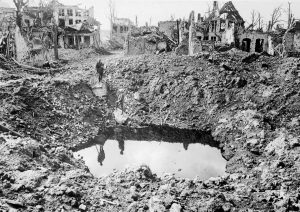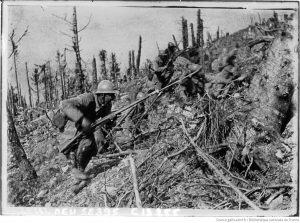
Australian War Memorial – Ypres, Belgium scarred and destroyed in the aftermath of a battle featuring a large shell crater
Noël des enfants qui n’ont plus de maison was among Claude Debussy’s last works and was written as Christmas was around the corner. The song was created both as a lament of the poor children’s situation as well as a vessel with which to criticize the war. At the time of writing the piece the Great War had been raging on for over a year and Belgium and France were already devastated by it. For example, in the article “Some Effects of the Great War upon France” by Sedley Ware, she writes “He told of over 600,000 houses, public buildings and factories wholly or partly destroyed…” (Ware 179) [4] The destruction resulting from the war was catastrophic and left a lasting impact on not just the land but families too, being heavily reflected by the themes and lyrics of Debussy’s song.

National Library of France – A bayonet charge led by French soldiers in the Argonne Forest, one of the deadliest battles of the war
The outbreak of World War I, also known as the Great War, engulfed Europe in a horrific period of bloodshed of never before seen magnitude, with the U.S. opting to provide support over direct involvement. However, German aggression forced America’s entrance, seeking a swift end to the devastation. A testament to the destruction faced by the war can be seen in the article, “The Impact of the First World War on Civilian Health in Britain” by J. M. Winter “… in I9I4-I8 on the basis of an average of prewar and postwar data, they concluded that over 400,000 British civilians died as a result of war conditions.” (Winter 488) [3] This is but a small fraction of the loss experienced by the war, and the use of chemical warfare further intensified such brutality while trench warfare contributed to the war’s horrific toll by prolonging battles into grueling stalemates. Additionally, dragging on with no end in sight led the war to become known as a “pointless war” also due to the disproportionate suffering to its cause. In the article “Morts Pour la France: A database of French fatalities of the Great War” by Victor Gay and Pauline Grosjean, “Over four years of battle, 8.3 million French men served in the army and 1.3 million among them died in combat…” [2], illustrating the degree of suffering this “pointless war” caused.

Library of Congress – A photo from an American military hospital in Neuilly operated by the American Red Cross
Music was heavily influenced by wartime conditions, with the dominating tones arising from war sentiments with some being patriotic or somber, and some as described in the book Music of the First World War by Don Tyler were “…disturbing, unstructured, and sometimes frightening.” (Tyler section 7) [1] Noël des enfants is among these songs being born from the war, discussing themes of chaos, destruction, loss, and the resulting despair. Furthermore, the song’s theme of children suffering is paralleled in “‘Till I Have Done All That I Can’ An Auxiliary Nurse’s Memories of World War I” by Michelle Moravec writes “Coudert, appalled by the hundreds of children fleeing the invasion of Alsace, began finding them temporary homes in Paris.” (Moravec 73) [5] America provided humanitarian relief for these children but were appalled by the sheer quantity of children suffering as a result of the war. Additionally, America who wished to stay out of the war was dragged into it and so too felt the same effects as European countries. As American casualties began to pile up, so too did the amount of loved ones back home who were devastated by the news.
Noël des enfants is written from the point of view of a child who is clearly angry and upset by all the loss they have experienced. The song mentions that the child’s mother had died and their father is at war, with the end of the song reiterating that they lost their home and even their bed. The song is from one child’s perspective, it speaks for the whole of the war’s victims and how they feel. Americans shared these sentiments even before entering the war feeling sympathy for its allies but would soon come to experience the same tragedy. While the song comes off as an angry outcry against the war due to the inflection and use of exclamation marks there is an underlying tragic theme regarding the use of Christmas in the song. Christmas is supposed to be a joyous time spent with your family in the home enjoying the quality time you get to spend with those you love. However, that was all robbed from these children by the Great War, with not just their homes but their families being lost as well.
[1] Don Tyler. Music of the First World War. Santa Barbara, California: Greenwood, 2016. https://research.ebsco.com/linkprocessor/plink?id=b8e3462c-281d-342b-be04-fd71c2be3dfb.
[2] Gay, Victor, and Pauline Grosjean. “Morts Pour La France: A Database of French Fatalities of the Great War.” Explorations in Economic History 90 (October 2023): 101550. https://doi.org/10.1016/j.eeh.2023.101550.
[3] Winter, J. M. “The Impact of the First World War on Civilian Health in Britain.” The Economic History Review 30, no. 3 (1977): 487–507. https://doi.org/10.2307/2594880.
[4] Ware, Sedley Lynch. “Some Effects of the Great War upon France.” The Sewanee Review 30, no. 2 (1922): 179–91. http://www.jstor.org/stable/27533535.
[5] Moravec, Michelle. “‘Till I Have Done All That I Can’ An Auxiliary Nurse’s Memories of World War I.” Historical Reflections / Réflexions Historiques 42, no. 3 (2016): 71–90. http://www.jstor.org/stable/44631082.
